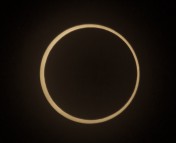This is a special post for our North American readers. In case you haven’t heard, there will be a partial solar eclipse today, visible from Mexico, Canada and the USA. “But wait!” you might say, “Didn’t we just have an eclipse?!” Yes, in fact, there was a lovely total lunar eclipse on October 8th. But today’s eclipse is a rarer solar eclipse.
Lunar vs. Solar Eclipses
Remember that a lunar eclipse occurs when the Earth passes between the Sun and Moon, casting a shadow on the Moon. Everyone on the half of the Earth that’s facing the Moon can view a lunar eclipse. But a solar eclipse occurs when the Moon passes between the Earth and Sun, casting a much smaller shadow on the Earth. You can only view a solar eclipse if you’re standing on the part of the Earth where the shadow falls, so it’s rarer to see a solar eclipse than a lunar eclipse (unless you’re willing to go on an eclipse expedition).
Lucky Coincidences in the Earth-Moon-Sun System
We get to enjoy solar eclipses thanks to a happy coincidence in the Earth-Moon-Sun system. The Moon is much smaller than the Sun, of course, but it’s just the right distance from Earth that the Moon and Sun have roughly the same apparent size in the sky. This means that when the Moon passes between us and the Sun, it’s just the right size to block the Sun’s light during a total solar eclipse.
This is lucky for eclipse fans, and if the Earth, Moon, and Sun orbited on the same plane, we’d get to see a total solar eclipse about once a month. In fact, we’d probably bored with them after a while. However, the tilt of the Moon’s orbit keeps eclipses from occurring more often than about every 18 months. Fig. 2 shows why the Moon’s 5° tilt makes solar eclipses rare.

Fig. 2: Diagram showing the effect of the tilt of the Moon’s orbit on the frequency of solar eclipses. (Credit: theconversation.com)
Observing the Eclipse
Today’s solar eclipse is only a partial eclipse, meaning that the Moon does not pass directly between the Earth and Sun, so it will only appear to take a bite out of the Sun rather than blocking it completely. This means that if you’re not trying to observe the eclipse, you probably won’t even notice it, since the Sun’s light will not dim significantly. So, what’s the best way to observe the eclipse?

Fig. 3: The gaps between the leaves of a tree can act as pinhole cameras, projecting the image of the eclipse onto the ground. (Credit: CSIRO)
First and most importantly, practice safe eclipse-viewing. Looking directly at the Sun for a long period can cause permanent damage to your vision, even during a partial eclipse. Looking through a telescope or binoculars at the Sun is even more dangerous! Even using a telescope to project an image of the eclipse onto a piece of paper can be dangerous, because the heat collected inside the telescope can damage it or break glass lenses or eyepieces.
Your best option is to visit a local observatory or astronomy club and take advantage of their expertise and equipment. If you’re on your own, you could try to get your hands on some eclipse glasses. Sunglasses won’t protect your eyes, even if they’re UV-blocking sunglasses, and neither will looking through undeveloped film or tinted glass. You need some solar-rated filtered glasses. I picked up a pair during the Venus transit back in 2012.
If it’s too late to find some filtered glasses, you can easily create a pinhole camera to project the image of the eclipse onto the ground or a piece of paper. If you want to build a pinhole camera, there are some great instructions here, but you can also just use anything that allows light to pass through one or more small holes, like a sieve or even the leaves of a tree (like in Fig. 3).
If it’s too cloudy where you are, you can check out one of the live streams from the Coca-Cola Science Center or the Mt. Lemmon SkyCenter. Fig. 4 shows a map of the start times of the eclipse, and the amount of light that will be blocked by the Moon, for different regions in North America. Sky & Telescope also has a table listing eclipse start and end times for different cities.

Fig. 4: Visibility map of the October 23 partial solar eclipse. (Credit: Sky & Telescope / Leah Tiscione)
If you do have access to a properly-filtered telescope, be sure to look for the huge sunspot, AR 2192. At 100,000 km across, this sunspot is big enough to swallow the Earth, and just yesterday it spit out an X-class solar flare. AR 2192 is easily visible through a solar telescope.
Even if you don’t have any equipment, I hope you North Americans will take the opportunity to step outside with a last-minute pinhole camera today to catch the eclipse. The next solar eclipse visible from North America won’t be until 2017, when we’ll get the chance to see a rare total solar eclipse!


